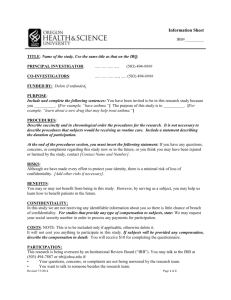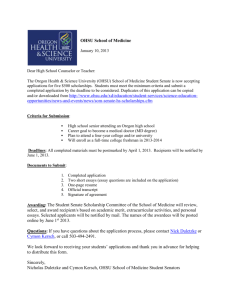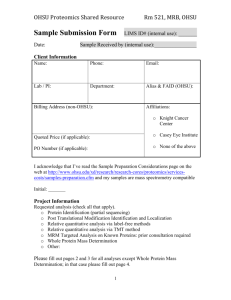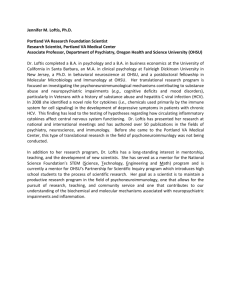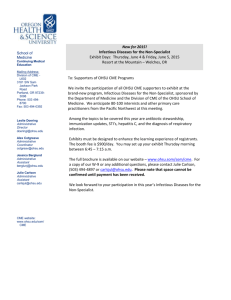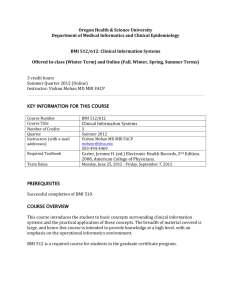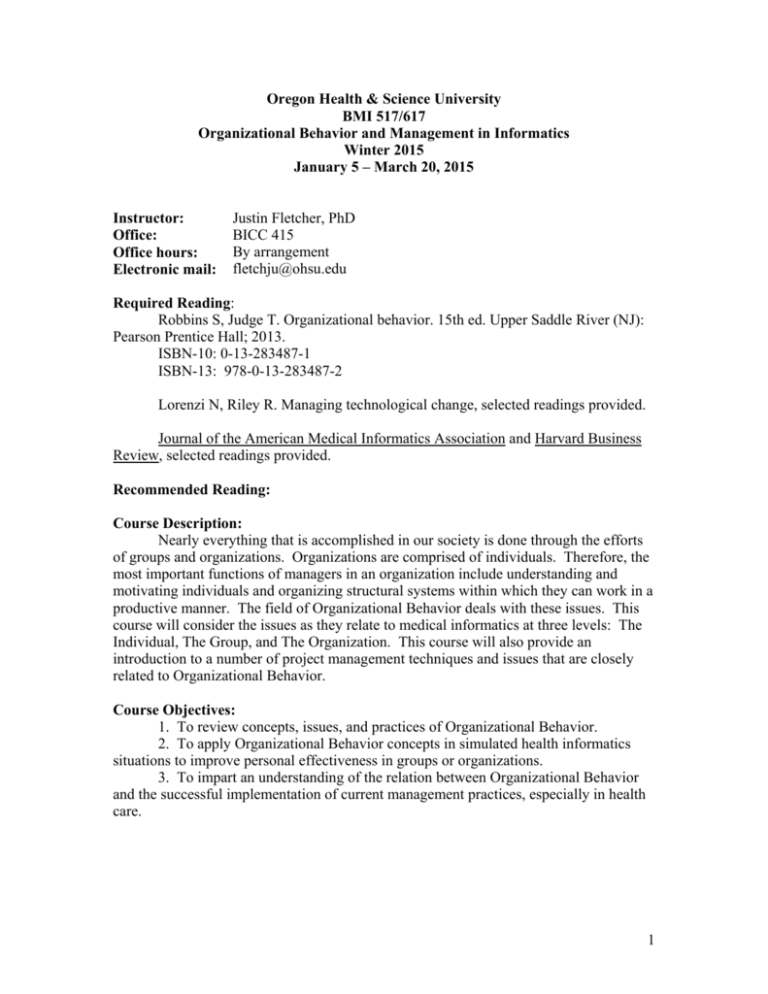
Oregon Health & Science University
BMI 517/617
Organizational Behavior and Management in Informatics
Winter 2015
January 5 – March 20, 2015
Instructor:
Office:
Office hours:
Electronic mail:
Justin Fletcher, PhD
BICC 415
By arrangement
fletchju@ohsu.edu
Required Reading:
Robbins S, Judge T. Organizational behavior. 15th ed. Upper Saddle River (NJ):
Pearson Prentice Hall; 2013.
ISBN-10: 0-13-283487-1
ISBN-13: 978-0-13-283487-2
Lorenzi N, Riley R. Managing technological change, selected readings provided.
Journal of the American Medical Informatics Association and Harvard Business
Review, selected readings provided.
Recommended Reading:
Course Description:
Nearly everything that is accomplished in our society is done through the efforts
of groups and organizations. Organizations are comprised of individuals. Therefore, the
most important functions of managers in an organization include understanding and
motivating individuals and organizing structural systems within which they can work in a
productive manner. The field of Organizational Behavior deals with these issues. This
course will consider the issues as they relate to medical informatics at three levels: The
Individual, The Group, and The Organization. This course will also provide an
introduction to a number of project management techniques and issues that are closely
related to Organizational Behavior.
Course Objectives:
1. To review concepts, issues, and practices of Organizational Behavior.
2. To apply Organizational Behavior concepts in simulated health informatics
situations to improve personal effectiveness in groups or organizations.
3. To impart an understanding of the relation between Organizational Behavior
and the successful implementation of current management practices, especially in health
care.
1
Additional Course Objectives:
1. To practice teamwork, especially virtual teamwork, in a self-directed team
fashion by selecting, working with, evaluating, and rewarding team members as
individuals and teams.
2. To apply the case method of analysis to simulated real life situations.
Course Grading:
Grades will be based on scores from examinations, written assignments, and team
and class participation. The point breakdown is as follows:
Team and class discussion
Team paper
Individual paper
Quizzes
25%
30%
30%
15%
Quizzes:
There will be three quizzes to be taken through Sakai.
Teams, Individual Papers, and Team Paper:
Early in the term, teams will form and select topics about which they will write a
case. Individuals will write papers (4 single spaced pages including references) offering
background for the team. A case will be written by the team (the Team Paper, 10 single
spaced pages or 20 double spaced plus references and appendices).
Papers must be typed and free of grammatical and spelling errors.
Team and class discussion:
Your grade for this will be based on class participation in the discussion board,
and also on effort and effectiveness in your teamwork. Team members will evaluate one
another.
Class participation is graded each week on a 5 point scale. You are expected to
participate in each discussion topic as you would an open discussion in class. Make your
points, comment on other's posts, and support your points during the week. You should
participate during the week, not just make a statement and never return. Posting earlier
in the week is recommended; it allows your points to be central to the discussion during
the week.
Policy on assignments:
Your assignments will be due at 5 p.m. Pacific time on Tuesdays. Note that late
assignments will incur severe grading penalties.
2
Class Schedule and Assignment List (subject to change)
_______________________________________________________________________
Date
Topic
Week 1
Jan 5 – 11
Week 3
Jan 19 - 25
Intro to O.B.
Individual
behavior
Values, etc.
Virtual teams
Searching the
Literature
Motivation
Groups
Week 4
Jan 26 – Feb 1
Teams
Communication
10 – 11
9
Week 5
Feb 2 – 8
Leadership
Power
12 – 13
Week 6
Feb 9 – 15
Conflict
Organizational
structure
Culture
Human
resources
Change
14 – 15
Week 2
Jan 12 – 18
Week 7
Feb 16 - 22
Week 8
Feb 23 – Mar 1
Week 9
Mar 2 – Mar 8
Week 10
Mar 9 – 15
Week 11
Mar 16 – 20
Project
management
Planning
Team papers
Chapters Chapters Other readings
in
In Riley
Robbins
1–2
1-3
Braude
Complete
3–6
Sittig
Gathering data
for cases
Quiz 1
7–9
Stanford Prison
Experiment
Team
proposal
14, 15
Hallowell
Dykstra
Patterson
Goleman
Quiz 2
6 - 10
Showdown case
16 – 17
18
Massaro
APACHE case
5, 7, 8,
12
11, 18
4
Individual
Paper
Quiz 3
HIT or Miss
video
Team
papers due
Mar 17
3
Course Grading Policy
Final grades are determined at the end of the quarter and usually are assigned as follows:
A
A‐
B+
B
B‐
C+
C
C‐
D/F
94 – 100
90 – 93
87 – 89
83 – 86
80 – 82
77 – 79
73 – 76
70 – 72
< 70
Graduate Studies in the OHSU School of Medicine is committed to providing grades to
students in a timely manner. Course instructors will provide students with information in
writing at the beginning of each course that describes the grading policies and procedures
including but not limited to evaluation criteria, expected time needed to grade individual
student examinations and type of feedback they will provide.
Class grades are due to the Registrar by the Friday following the week of finals.
However, on those occasions when a grade has not been submitted by the deadline, the
following procedure shall be followed:
1) The Department1 /Program Coordinator2 will immediately contact the Instructor
requesting the missing grade, with a copy to the Program Director and Registrar.
2) If the grade is still overdue by the end of next week, the Department1 /Program
Coordinator2 will email the Department Chair directly, with a copy to the Instructor and
Program Director requesting resolution of the missing grade.
3) If, after an additional week the grade is still outstanding, the student or
Department1/Program Coordinator2 may petition the Office of Graduate students for final
resolution.
1
For courses that are run by a specific department.
2
For the conjoined courses (course number is preceded by CON_ that are run by
Graduate Studies.
Academic Honesty
Academic honesty is required in order to pass this course. Students are encouraged to
help each other; nevertheless, all quizzes, written assignments and presentations must be
the work of the individual student. Literature and resources (including Internet resources)
employed in fulfilling assignments must be cited.
Likewise, students are expected not to collaborate on the answers to individual
assignments, although discussion of the concepts involved and working of similar
problems together is permitted.
4
See http://www.ohsu.edu/xd/education/library/researchassistance/plagiarism.cfm?WT_rank=1 for information on code of conduct for OHSU and
http://www.ohsu.edu/xd/education/teaching-and-learning-center/for-students/index.cfm
for more information on citing sources and recognizing plagiarism.
In an effort to uphold the principles and practice of academic honesty, faculty members
at OHSU may use originality checking systems such as Turnitin to compare a student’s
submitted work against multiple sources.
To protect student privacy in this process, it will be necessary to remove all personal
information, i.e. student name, email address, student u‐number, or any other personal
information, from documents BEFORE submission.
Copyright Information
Every reasonable effort has been made to protect the copyright requirements of materials
used in this course. Class participants are warned not to copy, audio, or videotape in
violation of copyright laws. Journal articles will be kept on reserve at the library or
online for student access. Copyright law does allow for making one personal copy of
each article from the original article. This limit also applies to electronic sources.
To comply with the fair use fair use doctrine of the US copyright law, Sakai course sites
close three weeks after grades are posted with the Registrar. Please be sure to download
all course material you wish to keep before this time as you will have no further access to
your courses.
Use of Sakai
This course will have an online component, which can be accessed through Sakai,
OHSU’s online course management system. For any technical questions or if you need
help logging in, please contact the Sakai Help Desk.
Hours: Sakai Help Desk is available Mon – Fri, 8 am – 10 pm and weekends and
holidays 12 pm – 5 pm.
Contact Information:
(Toll‐free) 877‐972‐5249
(Web) http://atech.ohsu.edu/help
(Email) sakai@ohsu.edu
Student Access
OHSU is committed to providing equal access to qualified students with disabilities.
Student Access determines and facilitates reasonable accommodations, including
academic adjustments and auxiliary aids, for students with documented disabilities. A
qualified student with a disability is a person who meets the academic and technical
standards requisite to admission or participation in a particular program of study. As
5
defined by the Americans with Disability Act (ADA), a person with a disability has a
physical or mental impairment that substantially limits one or more major life activities
of the individual. This may include, but is not limited to, physical conditions, chronic
health issues, sensory impairments, mental health conditions, learning disabilities and
ADHD. Student Access works with students with disabilities from all of OHSU’s
educational programs and at each campus.
Each school has an assigned Program Accommodation Liaison (PAL), who acts as an
“in‐house” resource for students and faculty concerning access issues for students with
disabilities. The PAL works in collaboration with Student Access to implement
recommended accommodations for students with disabilities.
It is recommended that you contact Student Access to consult about possible
accommodations if you a) received disability accommodations in the past, b) begin
experiencing academic difficulties, and/or c) are given a new diagnosis from your
healthcare provider.
Learn more about Student Access:
Phone: 503‐494‐0082
(Web) www.ohsu.edu/student‐access
(Email) studentaccess@ohsu.edu
DMICE Communication Policy
1. If the syllabus directs the student to contact the TA before contacting the instructor,
the student should do so. Otherwise, the student should contact the instructor and
allow 2 business days (not including weekends) for a response.
2. If the student does not receive a response from the instructor within 2 business days,
s/he should contact the TA (if there is one). When contacting the TA s/he should cc
the instructor and Diane Doctor at doctord@ohsu.edu.
3. If a student does not receive a response from the TA within 1 business day (not
including weekends), s/he should contact Diane Doctor at doctord@ohsu.edu and cc
the instructor and the TA.
4. If Diane does not reply within 1 business day (not including weekends), the student
should contact Andrea Ilg at ilgan@ohsu.edu.
5. Students having difficulties with Sakai should contact the Sakai Help Desk at
sakai@ohsu.edu or at (877) 972‐5249. Sakai help is available M‐F from 8am to
10‐pm and weekends from Noon to 5pm. Do not contact the instructor.
6

